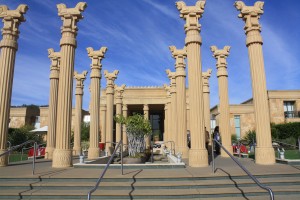Let’s say that you’re in some wonderful sector of Wine Country and all day long you’ve been tasting fabulous wines. If you’ve taken our advice, you’ve selected only the best wines to sip even if you had to pay a little more for the experience. At the better wineries, you could be enjoying a pour from bottles that go for a hundred dollars or in some instances, several hundred.
Then you go to dinner.
Remember that wine you liked so much this afternoon. Well, with the restaurant’s markup, that could make the price of drinking it with your meal unaffordably high. But there is a way around it: bring your own bottle. Remember, most restaurants charge a corkage fee if you bring a bottle with you. It could be as little as $10 per bottle or as high as $25.
But look at it this way. Restaurants mark up their wines between twice and three times the retail price. So if for example you loved a $75 wine, you might expect to pay $150 to $225 for this wine to accompany your meal. If you bring it with you, it would cost you only $100. Now, “only” is a relative term, but it certainly is cheaper than the price on the wine list.
If this is your plan, it could change the way you approach wine tasting during the day. If you know the restaurant at which you plan to dine that evening, call them and find out their corkage policy and fees. You might even ask what the specials of the day will be. Then go wine tasting with your dinner in mind.
Perhaps you’re planning on having a steak, a big, luscious steak. A Cabernet Sauvignon would be just the right wine to drink with it. And luckily enough, you’re in Napa Valley or Sonoma County (or Bordeaux or Chile) where they just happen to be famous for big, luscious Cabernet Sauvignons. As you go through the day, try the Cabernets that would fit your budget with the corkage fee added. When you’ve found the perfect wine, buy it and take it with you to dinner.
Of course, you might taste several “perfect” wines while you’re visiting the wineries. If you’re thinking of buying one for your evening meal, it’s a good idea to take a few notes as you go along and then decide which one is most to your liking or fits best with your dinner plans. You can then go back the winery where you tasted that wine and buy a bottle.
Here’s a little tip that will make bringing your wine even more attractive. Many restaurants, even some of the best, don’t charge corkage at all. They may place some restrictions on that policy. For example, Dry Creek Kitchen in Healdsburg only extends the no-corkage policy to wines made in Sonoma County. That still gives you a lot of room for maneuver. Another California restaurant with a no-corkage policy is Hurley’s in Yountville. We especially appreciate that the sommelier there gives extra attention to wines that are more than ten years old, because they and their corks can be a little more delicate.
There may be other restrictions, such as only certain nights when corkage is waived or a requirement that you buy one bottle off the list before they waive the corkage on the one you bring with you. A little advance planning pays off. There are lists on the web, but we’re not vouching for their accuracy. A few simple phone calls are the best bet.

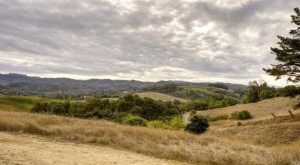
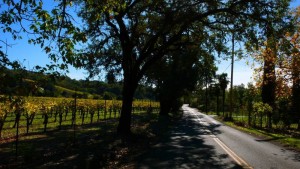
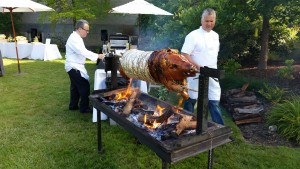 The guest of honor at Etude’s annual pig roast
The guest of honor at Etude’s annual pig roast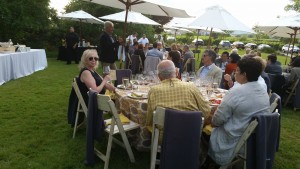 Lucie sips while Etude’s Jon Priest says a few words
Lucie sips while Etude’s Jon Priest says a few words